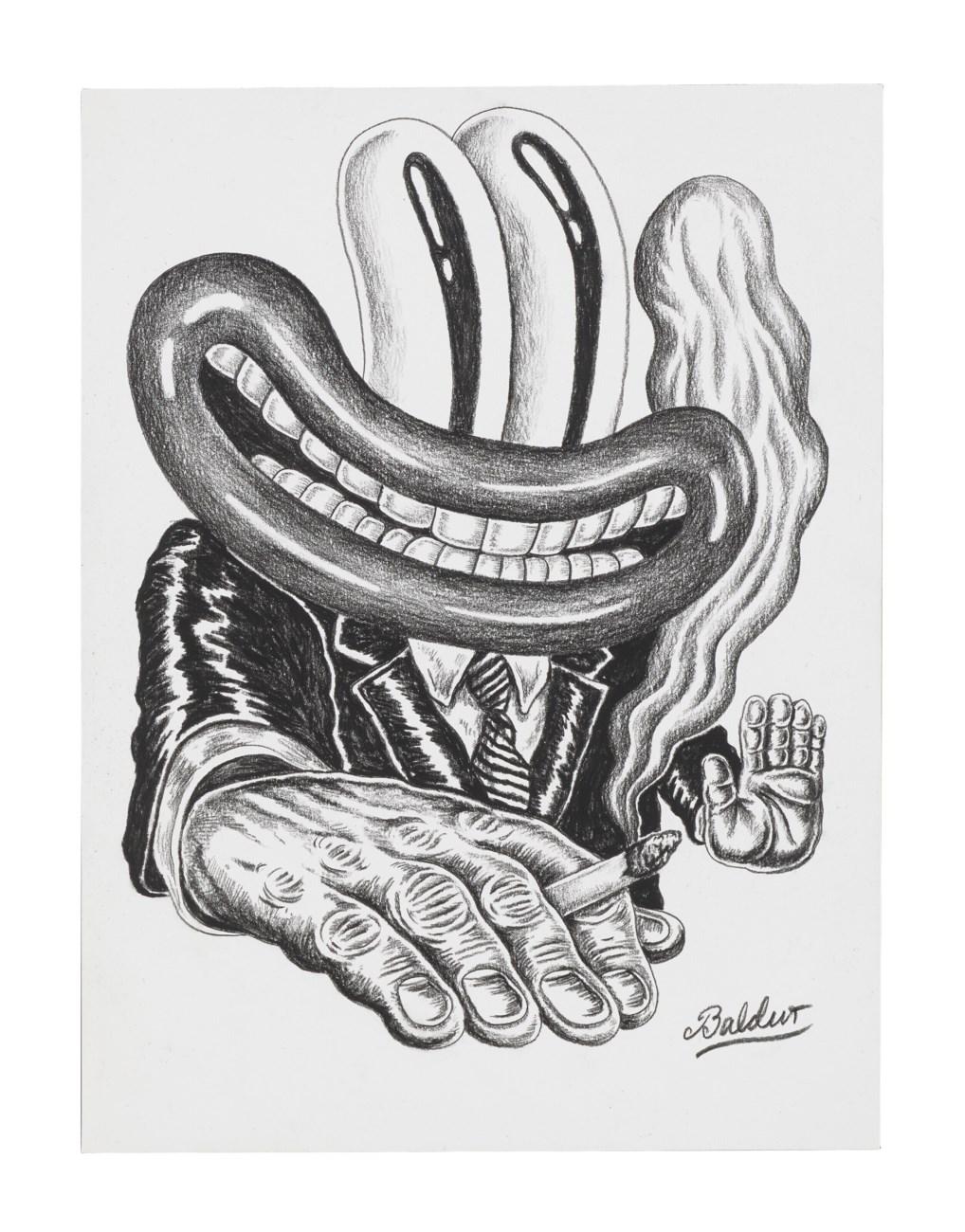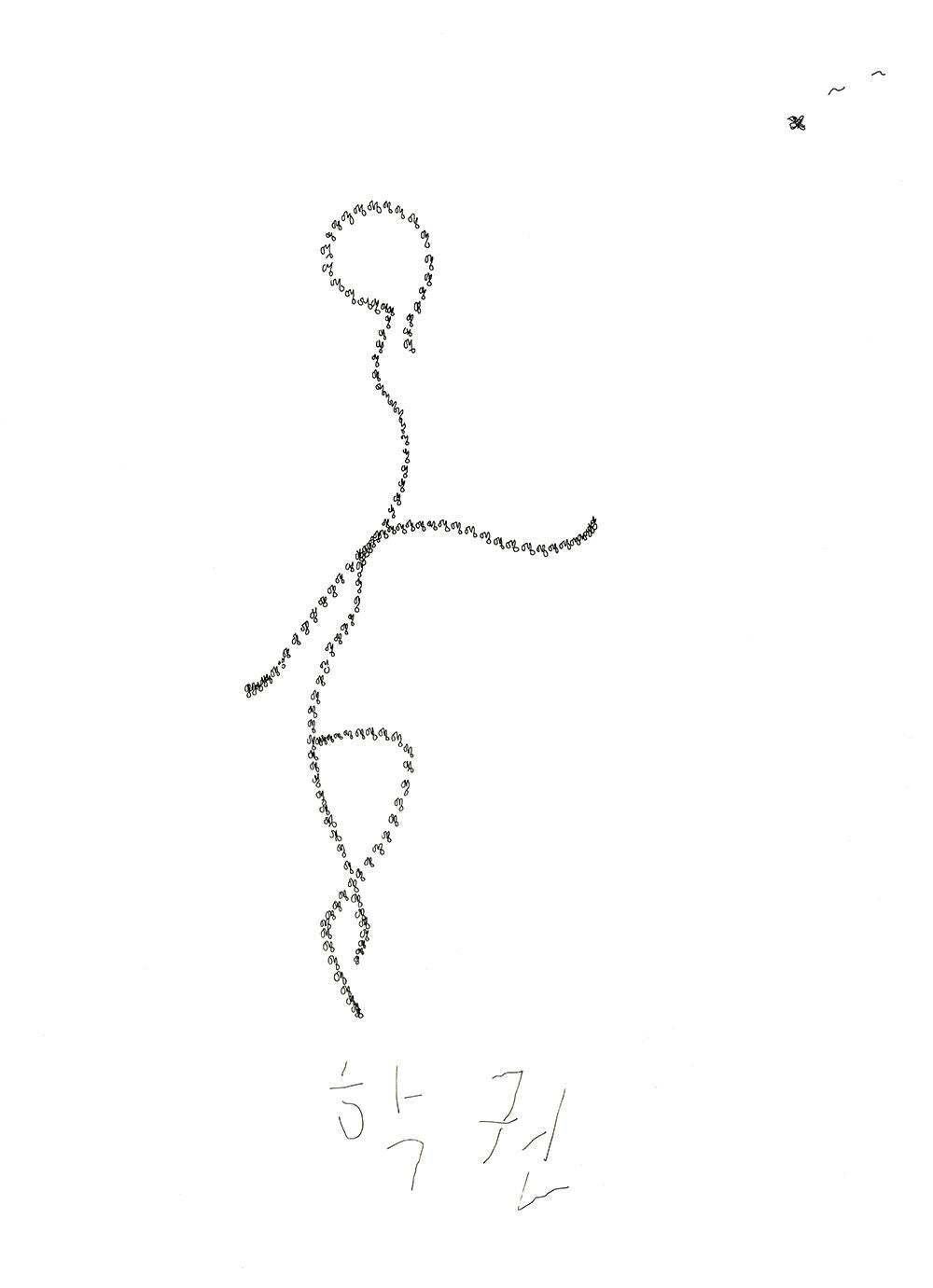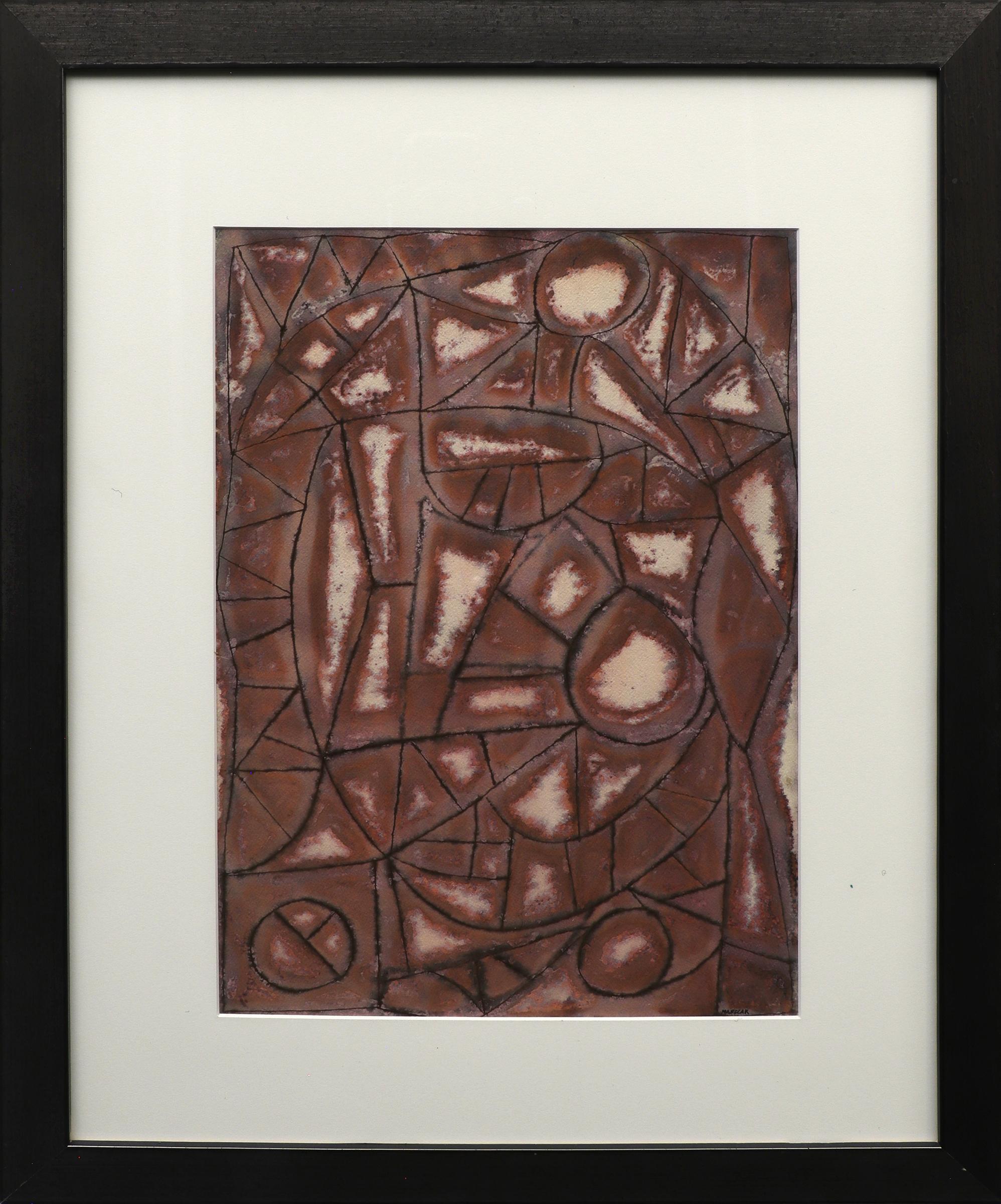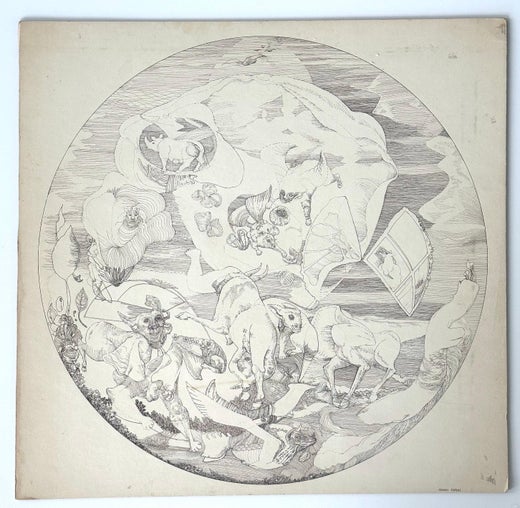Roland AyersAnimal Capers (Black Surrealist Artist)1969
1969
About the Item
- Creator:Roland Ayers (1932 - 2014, American)
- Creation Year:1969
- Dimensions:Height: 20 in (50.8 cm)Width: 20 in (50.8 cm)Depth: 0.1 in (2.54 mm)
- Medium:
- Movement & Style:
- Period:
- Condition:
- Gallery Location:Wilton Manors, FL
- Reference Number:1stDibs: LU245214452902
Roland Ayers
Roland Ayers was born on July 2, 1932, the only child of Alice and Lorenzo Ayers and grew up in the Germantown district of Philadelphia. Ayers served in the US Army (stationed in Germany) before studying at the Philadelphia College of Art (currently University of the Arts). He graduated with a BFA in art education, 1954. He traveled Europe, 1966–67, spending time in Amsterdam and Greece in particular. During this period, he drifted away from painting to focus on linear figurative drawings of a surreal nature. His return home inaugurated the artist’s most prolific and inspired period (1968–1975). Shortly before his second major trip abroad in 1971–72 to West Africa, Ayers began to focus on African themes and African American figures populated his work almost exclusively. Despite Ayers’ travel and exploration of the world, he gravitated back to his beloved Germantown, a place he endowed with mythological qualities in his work and literature. His autobiographical writing focuses on the importance of place during his childhood. Ayers’ journals meticulously document the ethnic and cultural make-up of Germantown and tell a compelling story of class marginalization that brought together poor families despite racial differences. The distinctive look and design of Germantown inform Ayers’ visual vocabulary. It is a setting with distinctive Gothic Revival architecture and haunting natural beauty. These characteristics are translated and recur in the artist’s imagery. During his childhood, one of the only books in the Ayers household was an illustrated Bible. The images within had a profound effect on the themes and subjects that would appear in his adult work. Figures in Ayers’ drawing often seem trapped in a narrative of loss and redemption. Powerful women loom large in the drawings, they suggest the female role models his journal record in early life. The drawings can sometimes convey a strong sense of conflict and at other times, harmony. Nature and architecture seem to have an antagonistic relationship that is, ironically, symbiotic. A critical turning point in the artist’s career came in 1971, when he was included in the extremely controversial Whitney Museum show, Contemporary Black Artists in America. The exhibition gave Ayers an international audience and served as a calling card for introductions he would soon make in Europe. Ayers is a particularly compelling figure in a period when black artists struggled with the idea of authenticity. A question often asked was “Is your work too black or not black enough?” Abstractionists were considered by some peers to be sell-outs, frauds or worse. Figurative work was accused of being either sentimental or politically radical depending on the critical source. Ayers made the choice early on to be a figurative artist but considered his work devoid of political content. Organizations such as Chicago’s Afri-Cobra in the late 1960s asserted that the only true black art of any relevance must depict the black man and woman. A martial agenda of this nature trivialized the work in Ayers’ view. A devotee of Eastern religions, Ayers sought to explore deeper subjects of a less topical nature, thereby stepping outside political discourse. This is not to suggest that he was a man who rejected the physical world. He was profoundly interested in awareness of the environment and how it relates to self-awareness. He often spoke of universality and timelessness as qualities to strive for in his art. Roland Ayers, In His Own Words, ”A person who refuses or is unable to give in to the consensus of his or her society may retain the capacity to see the world in a vastly different way. That person, in addition to having his or her construct of the world — and we all have that — usually has also retained the capacity to be more aware of that unique way of seeing as well as to use it."
- ShippingRetrieving quote...Ships From: Wilton Manors, FL
- Return PolicyA return for this item may be initiated within 7 days of delivery.
- Hesitation Blues (Black Surrealist Artist)By Roland AyersLocated in Wilton Manors, FLSurrealist proto-Afropunk drawing by African-American artist, Roland Ayers (1932-2014). Hesitation Blues, 1968. Ink on paper, sheet measures 13 x 23 inches; 14 x 18 inches in archiva...Category
1960s Surrealist Abstract Drawings and Watercolors
MaterialsInk, Archival Paper
- White Fronts Along the Coast (White Fronted Geese, Ireland Landscape)Located in Wilton Manors, FLRobert W. Milliken (Irish, 1920-2014). White Fronts Along the Coast, ca. 1960. Watercolor on paper, image measures 14.5 x 19.5 inches; 21.5 x 26.5 inches framed. Signed lower right. ...Category
Mid-20th Century Realist Landscape Drawings and Watercolors
MaterialsWatercolor
- Nude StudyBy Federico CastellonLocated in Wilton Manors, FLdouble-sided c.1950's drawing by Spanish artist, Federico Castellon (1914-1971). Ink on wove paper, sheet measures 10 x 13 inches; 21.5 x 24.5 inches in wood frame. Excellent condition with no restoration or damage. Signed with artist's chop in red ink seal that he used in Asia. From a recently discovered collection of over 60 important Castellon drawings and watercolors c.1939-1950. Birth place: Almeria, SpainDeath place: New York, NYAddresses: NYC (immigrated 1921; citizen, 1943)Profession: Painter, graphic artist, sculptor, etcher, illustrator, teacher Exhibited: Weyhe Gal., 1934, 1936-40; AIC, 1935-47 (prize, 1938); AFA traveling exh., 1937; WMAA, 1938-45; PAFA, 1938-39, 1940 (prize), 1941-42; Carnegie Inst., 1942; PAFA, 1943-53; Assoc. Am. Ar., 1946 (prize), 1952 (solo); Corcoran Gal, 1947; LOC, 1949 (prize); Paris, France, 1952; Bombay, India, 1952; Gallery 10, 1961; Dintenfass Gal., N.Y., 1963; Phila. Pr. Cl., 1964 (prize); Hudson Gld. A., 1964; Great Neck, L.I., 1964; SAGA, 1964 (prize). In 1953, under the auspices of State Dept. Specialist Div., of I.E.S., he exhibited in Venezuela, Colombia, Peru, Chile, Bolivia, Uruguay, Argentina, Paraguay, with lectures in each country. Awards: F., Spanish Republic, 1934-36; fellow, Guggenheim Fnd., 1941, 1950; Nat. Inst. A. & Let. Grant, 1950. Member: NA; SAGAWork: WMAA; PAFA; MoMA; PMA; MMA; BM; AIC; NYPL; LOC; Univ. KY; San Diego Mus. FA; Newark (NJ) Pub. Lib.; Princeton Univ. (Frank Jewett Mather Coll.). Comments: A Surrealist painter whose imagery of the 1930s was greatly influenced by Dali. His full name was Federico Cristencia de Castellón y Martinez. Teacher: Columbia Univ., 1946-61; Pratt Inst., Brooklyn, 1952-61. Illustrator: Shenandoah, 1941; I Went into the Country, 1941; Bulfinch's Mythology, 1948; The Story of Marco Polo, 1954; The Man Who Changed China, 1954; The Story of J. J. Audubon, 1955; The Little Prince, 1954; The Life of Robert L. Stevenson, 1954. Reproduction of paintings on The Sumerian Civilization" for Life series "The Epic of Man," 1956; 15 paintings on "The History of Medicine" for MD magazine, 1960-61; The Story of Madame Curie...Category
Mid-20th Century Cubist Nude Drawings and Watercolors
MaterialsPaper, Ink
- Untitled Floral Still LifeLocated in Wilton Manors, FLBeautiful floral still life by American artist Jane Piper (1916-1991) . Pastel, oil crayon and pencil on tracing paper. Image measuring 13 x 15.5 inches in ...Category
1980s Abstract Still-life Drawings and Watercolors
MaterialsParchment Paper, Crayon, Pastel, Pencil
- Portrait of AikoLocated in Wilton Manors, FLSeiichi Hara (Japanese). Portrait of Aiko, 1972. Pencil, gouache on paper. Sheet measures 16 x 20 inches. Signed lower right and en verso. Custom frame of hardwood with welded steel ...Category
1970s Abstract Abstract Drawings and Watercolors
MaterialsPaper, Gouache, Pencil
- Surrealist HoundLocated in Wilton Manors, FLAmazing surrealist painting by Italian artist Nuccio Fontanella (1936-2005). Ink and watercolor on cold pressed illustration board. Image measures 13 x 18 inches; 20 x 25 inches fram...Category
1980s Surrealist Animal Paintings
MaterialsInk, Illustration Board, Watercolor
- Baldur Helgason drawing 2018 (Baldur Helgason dog)Located in NEW YORK, NYBaldur Helgason drawing 2018: Baldur Helgason Jorgen the Dog Day: A robust, lively Helgason hand-drawing defined by the artist’s signature style. Med...Category
21st Century and Contemporary Surrealist Animal Drawings and Watercolors
MaterialsPaper, Wax Crayon
- "Le combat des poissons "Pencil study with annotations , cm. 30 x 20 1940 caBy André MassonLocated in Torino, ITAndré Masson ( 1896-1987) Pencil study with annotations on the right side, acquired by the previous owner from Luis Masson son of Andrè MassonCategory
1940s Surrealist Animal Drawings and Watercolors
MaterialsPaper, Pencil
- SWAN IN LOVE (TEOREMA 50)By Christina McPheeLocated in New York, NYSWAN IN LOVE (TEOREMA 50), 2012 ink, watercolor, airbrush paint, graphite on paper 37.5 x 52 inches / 952 x 1320 mm unframed Christina McPhee’s expansive abstract paintings, drawings, photographs, and videos test or query how can we know, and who is we? Moving from within a matrix of measurement, observation and contingent effects, her work resists characterization as product, and continually accesses fields outside itself. For her, process equals trial. Her work emulates potential forms of life, in various systems and territories, from a perspective of the non-self– a world beyond identity. McPhee’s dynamic, performative, physical engagement with materials, in both her analogue and digital works, is a seduction into surface-skidding calligraphic gestures and mark-making. The tactics of living are in subterfuge, like the ‘dazzle ships...Category
21st Century and Contemporary Contemporary Abstract Drawings and Waterco...
MaterialsArchival Ink, Archival Paper
- TranquilityBy Milan Kaplan AltabetLocated in Santa Monica, CASurrealism has been my passion since a young age. The concept of being able to manifest my visions into a space where it can be seen and interacted with has always been fascinating...Category
2010s Surrealist Abstract Drawings and Watercolors
MaterialsPencil
- HAK KWON (Crane martial art)Located in Seoul, KRAbout ‘Hak Kwon’ Hak Kwon is a phonetic representation of the Korean characters 학 and 권. The Korean word Hak means crane and Kwon refers to a kind of martial arts. About Seungho YOO...Category
2010s Contemporary Abstract Drawings and Watercolors
MaterialsPaper, Ink
- The Chicken, 1940s Abstract Geometric Pen Ink Drawing, Red, Black, CreamBy Edward MarecakLocated in Denver, CO"The Chicken", is ink on paper by Denver artist Edward Marecak (1919-1993) from the 1940's of an abstract depiction of a chicken in black and red. Presented in a custom black frame, outer dimensions measure 23 ¾ x 19 ¾ inches. Image size measures 15 ¾ x 11 ½ inches. Drawing is clean and in very good condition - please contact us for a detailed condition report. Provenance: Estate of the Artist, Edward Marecak Expedited and international shipping is available - please contact us for a quote. About the Artist: Born to immigrant parents from the Carpathian region in Slovakia, Marecak grew up with his family in the farming community of Bennett’s Corners, now part of the town of Brunswick, near Cleveland, Ohio. When he turned twelve, his family moved to a multi-ethnic neighborhood of Poles, Czechs, Slovaks and Slovenians in Cleveland. His childhood household cherished the customs and Slavic folk tales from the Old Country that later strongly influenced his work as a professional artist. During junior high he painted scenery for puppet shows of "Peter and the Wolf," awakening his interest in art. In his senior year in high school he did Cézanne-inspired watercolors of Ohio barns at seventy-five cents apiece for the National Youth Administration. They earned him a full scholarship to the Cleveland Institute of Art (1938-1942) where he studied with Henry George Keller whose work was included in the 1913 New York Armory Show. In 1940 Marecak also taught at the Museum School of the Cleveland Institute. Before being drafted into the military in 1942, he briefly attended the Cranbrook Academy of Art near Detroit, one of the nation’s leading graduate schools of art, architecture, and design. A center of innovative work in architecture, art and design with an educational approach built on a mentorship model, it has been home to some of the world’s most renowned designers and artists, including Eero Saarinen, Charles Eames, Daniel Libeskind and Harry Bertoia. Marecak’s studies at Cranbrook with painter Zoltan Sepeshy and sculptor Carl Milles were interrupted by U.S. army service in the Aleutian Islands during World War II. Following his military discharge, Marecak studied on the G.I. Bill at the Colorado Springs Fine Arts Center from 1946 to 1950, having previously met its director, Boardman Robinson, conducting a seminar in mural painting at the Cleveland Institute of Art. Although he did not work with Robinson at the Fine Arts Center, who had become quite ill - retiring in 1947 - he studied Robinson’s specialty of mural painting before leaving to briefly attend the Cranbrook Academy in 1947. That same year he returned to the Fine Arts Center, studying painting with Jean Charlot and Mary Chenoweth, and lithography with Lawrence Barrett with whom he produced some 132 images during 1948-49. At the Fine Arts Center he met his future wife, Donna Fortin, whom he married in 1947. Also a Midwesterner, she had taken night art courses at Hull House in Chicago, later studying at the Art Institute of Chicago with the encouragement of artist Edgar Britton. After World War II she studied with him from 1946 to 1949 at the Fine Arts Center. (He had moved to Colorado Springs to treat his tuberculosis.) Ed Marecak also became good friends with Britton, later collaborating with him on the design of large stained glass windows for a local church. In 1950-51 Marecak returned to the Cleveland Institute of Art to complete his Bachelor of Fine Arts degree. A year later he was invited to conduct a summer class at the University of Colorado in Boulder, confirming his interest in the teaching profession. In 1955 he received his teaching certificate from the University of Denver. Vance Kirkland, the head of its art department, helped him get a teaching job with the Denver Public Schools so that he and his family could remain in the Mile High City. For the next twenty-five years he taught art at Skinner, Grove, East, George Washington and Morey Junior High Schools. Prior to coming to Colorado, Marecak did watercolors resembling those of Winslow Homer, John Singer Sargent and Charles Burchfield. However, once in Colorado Springs he decided to destroy much of his earlier ouevre, embarking on a totally new direction unlike anything he had previously done. Initially, in the 1940s he was influenced by surrealist imagery and Paul Klee, and in the West by Indian petroglyphs and Kachinas. His first one-person show at the Garrett Gallery in Colorado Springs in 1949 featured paintings and lithographs rendered in the style of Magic Realism and referential abstraction. The pieces, including an oil Witch with Pink Dish, foreshadowed the output of his entire Colorado-based career, distinguished by a dramatic use of color, intricacy of execution and attention to detail contributing to their visual impact. He once observed, "Each time I start a new painting I always fool myself by saying this time keep it simple and not get entangled with such complex patterns, color and design; but I always find myself getting more involved with richness, color and subject matter." An idiosyncratic artist proficient in oil, acrylic, watercolor, gouache and casein, he did not draw upon Colorado subject matter for his work, unlike many of his fellow painters in the state. Instead he used Midwest landscape imagery, bringing to life in it witches and spirits adapted from the Slovakian folk tales he heard growing up in Ohio. A number of his paintings depict winter witches derived from the Slovak custom in the Tatra Mountains of burning an effigy of the winter witch in the early spring to banish the memory of a hard winter. The folk tale element imparts a dream-like quality to many of his paintings. A devote of Greek mythology, he placed the figures of Circe, Persephone, Sybil, Hera and others in modern settings. The goddess in Persephone Brings a Pumpkin to her Mother, attired as a Midwestern farmer’s daughter, heralds the advent of fall with the pumpkin before departing to spend the winter season in the underworld. Train to Olympus, the meeting place of the gods in ancient Greece, juxtaposes ancient mythology with modernity creating a combination of whimsy and thought-provoking consideration for the viewer. Voyage to Troy #1 alludes to the ancient city that was the site of the Trojan Wars, but has a contemporary, autobiographical component referencing the harbor of the Aleutian Islands recaptured from the Japanese during World War II. In the 1980s Marecak used the goddess Hera in his painting, Hera Contemplates Aspects of the Art Nouveau, to comment on art movements in the latter half of the twentieth century Marecak’s love of classical music and opera, which he shared with his wife and to which he often listened while painting in his Denver basement studio, is reflected in Homage of Offenbach, an abstract work translating the composer’s musical colors into colorful palette. Pace, Pace, Mio Dio, the title of his earliest surrealist painting, is a soprano aria from Verdi’s opera, La Forza del Destino (The Force of Destiny or Fate, a favorite Marecak subject). His Queen of the Night relates to a character from Mozart’s opera, The Magic Flute. In addition to paintings and works on paper, he produced hooked rugs, textiles and ceramics. He likewise produced designs for ceramics, tableware and furniture created by his wife Donna, an accomplished Colorado ceramist. Both of them generally eschewed exhibitions and galleries, preferring to quietly do their work while remaining outside of the mainstream. He initially exhibited at the Colorado Springs Fine Arts Center in 1948 receiving a purchase award. The following year he had his first one-person show of paintings and lithographs at the Garrett Gallery in Colorado Springs. In the 1950s and early 1960s he participated in group exhibitions at the Print Club (Philadelphia); Amarillo Public Library (Texas); annual Blossom Festival Show (Canon City, Colorado); Adele Simpson’s "Art of Living" in New York; Denver Art Museum; and the Fox Rubenstein-Serkey Gallery (Denver); but he did not have another one-person show until 1966 at the Denver home of his friends, John and Gerda Scott. They arranged for his first one-person show outside of Colorado held two years later at the Martin Lowitz Gallery in Beverly Hills and Palm Springs, California. That same year his work was featured at the Zantman Galleries in Carmel, California. Thereafter he became an infrequent exhibitor after the 1970s so that his work was rarely seen outside his basement studio. In 1980 he, his wife and Mark Zamantakis exhibited at Denver’s Jewish Community Center, and four years later he had a one-person show at the Studio Gallery in Denver. In 1992 he was included in a group show at the Rule Modern and Contemporary Gallery in Denver, and a year later received a large, posthumous retrospective at the Emmanuel...Category
1940s Abstract Geometric Abstract Drawings and Watercolors
MaterialsPaper, Ink






